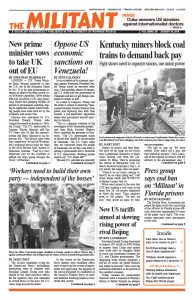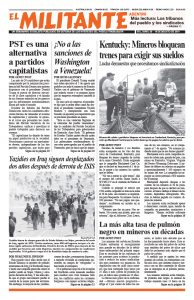President Donald Trump threatened to impose 10% tariffs on $300 billion of imports from China next month after trade talks in Shanghai failed to reach any agreement between the U.S. and Chinese governments. The deepening trade dispute triggered a sell-off of stocks on global markets and added to investors’ fears over the worldwide slowdown in the growth of the capitalist economy.
Trump claimed his protectionist measures were a response to Beijing’s failure to follow through on pledges to buy more U.S.-made food products. In turn, Beijing warned it would take “necessary countermeasures” if the duties are enforced.
The move escalated the tensions between Washington, the world’s dominant but declining imperialist power, and its biggest rival, the emerging power in Beijing. The U.S. rulers rely on their huge domestic market and the preponderance of the dollar in world trade as well as their unrivaled military might, hoping to hold off the rise of the Chinese rulers and offset their own decline.
Beijing seeks to assert its influence through huge loans to governments across Asia and the Pacific; infrastructure projects that facilitate the trade of Chinese bosses; and by the massive expansion of their navy and the establishment of military bases on islands across the South China Sea.
U.S. exports to China are only a fraction of those flowing the other way, so Beijing can’t match Washington tariff for tariff. But it is taking other measures. The Chinese government allowed its currency to slide lower Aug. 5 to partially offset any price rises caused by the new tariffs. Trump immediately denounced Beijing’s “currency manipulation.”
Behind Trump’s tariff assault, the U.S. rulers have been trying to push back on Beijing’s various forms of hidden protectionism — such as forcing foreign investors to transfer technology to their Chinese collaborators, as well as hefty subsidies to China’s state-owned enterprises.
The duties could add to the costs of consumer goods, from shoes to clothing, car parts to cellphones. This is on top of existing 25% punitive duties on $250 billion in Chinese imports.
The U.S. Chamber of Commerce and other capitalist spokespeople, like Trump’s former economic adviser Gary Cohn, have raised concerns that the protracted tariff dispute is starting to damage the U.S. economy.
While the sharpening rivalry between Washington and Beijing is often portrayed as a matter of trade imbalances — with Trump claiming his tariffs will boost the U.S. economy and create more jobs — Washington’s primary concern is securing its military dominance. Maintaining its preeminent position in telecommunications, electronics, aerospace and shipbuilding industries is key for this.

